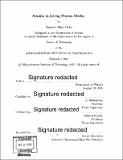Studies in living porous media
Author(s)
Ocko, Samuel Alan
DownloadFull printable version (14.89Mb)
Other Contributors
Massachusetts Institute of Technology. Department of Physics.
Advisor
L. Mahadevan and Mehran Kardar.
Terms of use
Metadata
Show full item recordAbstract
Many biological systems need to control transport of nutrients and ventilation. Unlike many nonliving porous media, they modify themselves to meet these demands; they are active. Using a combination of experiment, theory, and computation, we investigate several living porous media. First we consider termite mounds, meter-sized structures built by insects nearly three orders of magnitude smaller than the mounds themselves. It is widely accepted that the purpose of these mounds is to give the colony a controlled microhabitat that buffers the organisms from strong environmental fluctuations while allowing them to exchange energy and matter with the outside world. However, previous work toward understanding their functions has led to conflicting models of ventilation mechanisms and little direct evidence to distinguish them. By directly measuring air flows inside mounds of the Indian termite Odontotermes obesus, we show that they use diurnal ambient temperature oscillations to drive cyclic flows inside the mound. These cyclic flows in the mound flush out CO2 from the nest and ventilate the colony, in a novel example of deriving useful work from thermal oscillations. We also observe the same diurnally-driven flows in mounds of the African termite Macrotermes michaelseni, evidence that this is likely a general mechanism. We then consider the problem of honeybee swarming, wherein thousands of bees cling onto each other to form a dense cluster that may be exposed to the environment for several days. During this period, the cluster has the ability to maintain its core temperature actively without a central controller. We suggest that the swarm cluster is akin to an active porous structure whose functional requirement is to adjust to outside conditions by varying its porosity to control its core temperature. Using a continuum model that takes the form of a set of advection-diffusion equations for heat transfer in a mobile porous medium, we show that the equalization of an effective "behavioral pressure", which propagates information about the ambient temperature through variations in density, leads to effective thermoregulation. Our model extends and generalizes previous models by focusing the question of mechanism on the form and role of the behavioral pressure, and allows us to explain the vertical asymmetry of the cluster (as a consequence of buoyancy driven flows), the ability of the cluster to overpack at low ambient temperatures without breaking up at high ambient temperatures, and the relative insensitivity to large variations in the ambient temperature. Our theory also makes testable hypotheses for the response of the cluster to external temperature inhomogeneities, and suggests strategies for biomimetic thermoregulation. Finally, we consider a generic model of an active porous medium where the conductance of the medium is modified by the flow and in turn modifies the flow, so that the classical linear laws relating current and resistance are modified over time as the system itself evolves. This feedback coupling is quantified in terms of two parameters that characterize the way in which addition or removal of matter follows a simple local (or non-local) feedback rule corresponding to either flow-seeking or flow-avoiding behavior. Using numerical simulations and a continuum mean field theory, we show that flow-avoiding feedback causes an initially uniform system to become strongly heterogeneous via a tunneling (channel-building) phase separation; flow-seeking feedback leads to an immuring(wall-building) phase separation. Our results provide a qualitative explanation for the patterning of active conducting media in natural systems, while suggesting ways to realize complex architectures using simple rules in engineered systems.
Description
Thesis: Ph. D., Massachusetts Institute of Technology, Department of Physics, 2015. Cataloged from PDF version of thesis. Includes bibliographical references (pages 69-76).
Date issued
2015Department
Massachusetts Institute of Technology. Department of PhysicsPublisher
Massachusetts Institute of Technology
Keywords
Physics.